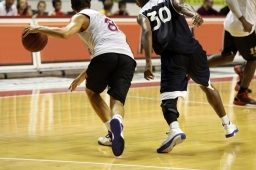Overtraining in High-School Athletes - The “Always-In-Season” athlete…
Tuesday, September 2, 2014 - 15:34

By Konrad Wiltmann
Algonquin Sport Business Management student
Many high-school athletes compete in a wide variety of sports over the course of the school year, while maintaining their studies, social life, and sometimes a part-time job. It is not uncommon for a high-school athlete to be “in-season” the whole year. From participating in soccer and cross-country running in the fall, to basketball and skiing in the winter, and finally to track and field in the spring, many teenagers are in competition the entire school year. All of these commitments can lead to overtraining, high stress levels and may cause an athlete to drop out of sport altogether.
- Overtraining is defined as “untreated overreaching, that results in long-term decreased performance and an impaired ability to train,” or more specific to student-athletes, “imbalance between stress and recovery.” Stress factors include training, class schedules, exams, competitive schedules, travel, lifestyle patterns, and emotional turmoil. Student-athletes should avoid playing more than four sports during the school year.
- Sleep is an important preventive measure against overtraining. Most high-school athletes do not get enough sleep. The recommended number of hours of sleep for teenagers is nine. Parents and coaches can help educate their athletes on proper sleep hygiene by providing them with the following guidelines: a) establishing a regular bedtime. b) Avoiding caffeinated beverages in the evening. c) Preparing a quiet and comfortable sleep environment.
- Recovery is just as important as the actual training itself. If an athlete is not recovering, future training will not provide any benefits and is rendered pointless. Important recovery guidelines include proper nutrition and doing active recovery workouts including yoga or an easy cross-training activity.
Signs and symptoms of overtraining include:
- An increased resting heart rate
- A loss of bodyweight
- A decrease in appetite
- Muscle soreness that lasts more than 24 hours
- An increase in illness
- A decrease in performance
- A lack of desire in training or competing
High school-aged athletes are in one of the most stressful periods of their life. They face pressure from parents, coaches, and teachers to perform athletically, academically, and sociably. This is why it’s important to be aware of the warning signs related to overtraining syndrome. If recognized early, most of these issues can be resolved with improved nutrition or rest, before resulting in more serious problems.
References from the SIRC Collection:
1. Faigenbaum, A. D., Mediate, P. P., & Rota, D. D. (2002). Sleep need in high school athletes. Strength & Conditioning Journal, 24(4), 18-19.
2. FAVERO, T. (2009). The Rest of the Story. Training & Conditioning, 19(5), 31-36.
3. Jeffreys, I. I. (2004). A system for monitoring training stress and recovery in high school athletes. Strength & Conditioning Journal, 26(3), 28-33.
4. Kellmann, M. M. (2010). Preventing overtraining in athletes in high-intensity sports and stress/recovery monitoring. Scandinavian Journal Of Medicine & Science In Sports, 2095-102.